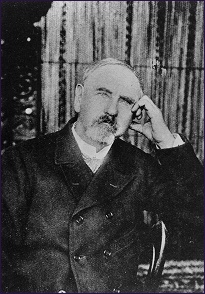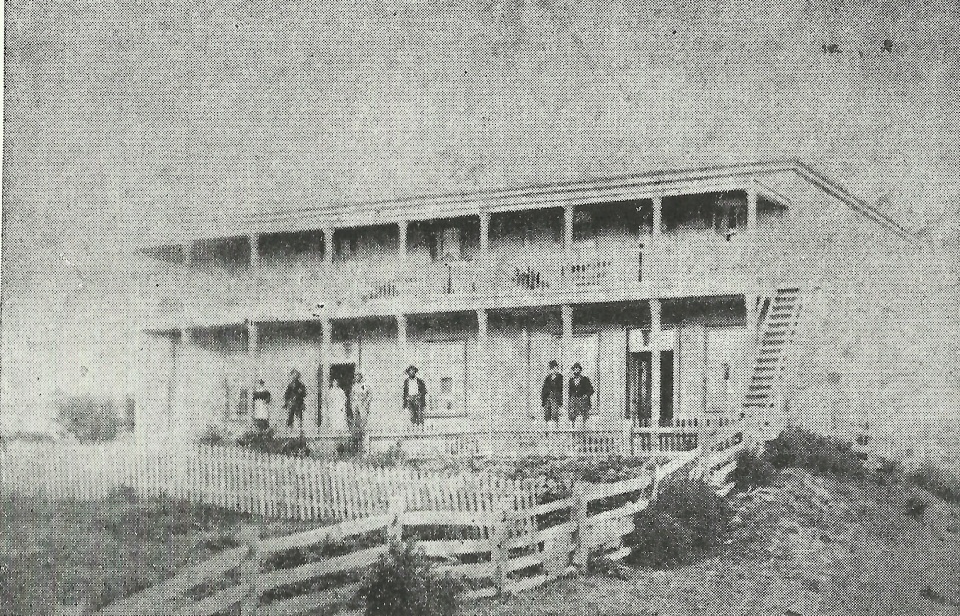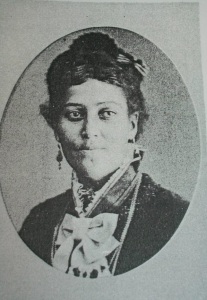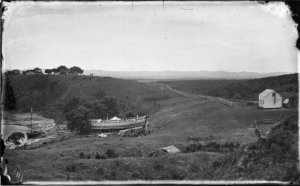Ihapere or Isabella Stanaway was born on 7 February 1847 (birth certificate number unknown) in the Hokianga region. She was the second daughter of John and Henipapa.
 Ihapere Isabella Stanaway
Ihapere Isabella StanawayFrom our research we know that the children of JJ and Henipapa lived with their mother in the pa on the opposite side of the river to John. We are not sure at what age but she decided that she would rather live with her father. Together with her younger brother Henry they swim across the river and live with their father.
It appears that all the children who lived with John were put to work with him, it is at the age of 17 while helping her father bring a ship into the Kaipara Harbour, she caught the eye of a 35-year-old Charles Nelson.
Ihapere married Charles Nelson on 28 April 1864, the wedding was held in Auckland in a church on Victoria Street. Charles was Swedish and his real name was Carl Esaias Nilsson, he was the son of Professor Sven Nilsson of the University of Lund, and Cecilia Berg. He was born in Lund, Sweden in 1829 where he was also raised with five other siblings. His fathers chosen fields were zoology and archeology.
It is worth providing some background on Charles before we continue.
At an early age he chose a career at sea, by the age of 19 Charles had graduated as a Master Marriner. From this time on he roamed the oceans of the world, and was involved in whaling, trading and for a brief time, slave transport. It was while whaling around the Pacific that he first meet Maori, he visits New Zealand on a number of occasions and it was not until 1858 he decides to settle in Mataia Glorit (just north of Helensville) New Zealand. (Maori Wars of the Nineteenth Century by S Percy Smith page 480 confirms that he was one of 5 Europeans living in the Kaipara).
Charles (no doubt with encouragement from his father) was a proficient linguist and had become fluent in a number of languages (17 in total), with Maori being one of them. While helping Maori build boats he starts to study their language and lore more, sending back to his father, notes sketches and artifacts, much to the delight of his father (these sketches, letters and artifacts are still in the Professor Sven Nilsson’s new collection to this day).
It is worth noting that he was also at one point in the employment of Brown Campbell and Co as captain of the brigantine Seagull.
From the book “A White Tohunga” by P&G Kullberg – Page 40 and 41 we read;
He (JJ Stanaway) married a Maori woman of high rank, Henipapa Minarapa, of the Rarawa tribe, when he was working in the timber trade at Hokianga. During most of his life he lived at Whakahara in the Tokatoka district in Kaipara Harbour. He used to climb the Tokatoka Peak to watch for ships heading towards the harbour.
He married three times (two Maori wives and one European) and in time he had a total of 11 children. One of his daughters Isabella (Ihapera) was born on February 17th 1847. Isabella was going to be a very important person for Charles 17 years later.
Isabella’s mother, Henipapa Minarapa, was a Maori chief’s daughter and her children by John James Stanaway were first brought up within the Maori family. Isabella wanted to be with her father and one day, when still a child, she took her little brother Henry, their clothes on her back, and swam over the Wairoa River to her father.
According to his descendants living today, one day Charles came on deck in his shirttails to start moving the ship towards the Kaipara Bars a beautiful half-caste girl, Isabella, stood at the steering wheel helping to pilot. This was the start of a happy period in Charles’s life. Isabella was seventeen, and Charles was thirty-five when they married in Victoria Street, Auckland on 28 April 1864. They settled in Helensville, where Isabella held land at the crossing of the Commercial and Rimu Streets.
 Charles Nelson – A White Tohunga.
Charles Nelson – A White Tohunga.Ihapere and Charles were among the founding family’s in Helensville – Nelson Street is named after the family. Initially out of necessity they started to open their home to weary travellers, then they opened a boarding house then they built the Kaipara Hotel. From an article in the Rodney Time 18 October 2012 we read;
Isabella was reputed to be ‘‘of a gentle nature’’ and very hospitable, providing a real haven for weary travellers.
Then from Men Came Voyaging, Chapter 8 – The Birth of Helensville – page 57-58 we read;
With so many folk choosing to reach their special settlements in Kaipara by this route, transport became a problem. Delays up to a month in tents at Riverhead or Te Awaroa (Helensville) were usual and by the time the latter place was reached, Albertlanders could already speak feelingly of troubles experienced in New Zealand…… To convey these folk to Albertland there bore down on Te Awaroa between September and Christmas, a motley fleet of little boats…. Captain Charles Nelson, who had been living at Mataia, the home of his half-caste wife, came to help with the exodus.
And further we read from Men Came Voyaging, Chapter 8 – page 60;
Close to the mill, Charles Nelson and his wife Ihapere, presently established a boarding house. Mr. Nelson, born 1829, was Swedish and Greek by birth, a son of Professor Nilssen of Lund University. Charles went to sea in 1944 and after coming to New Zealand intermittently since 1852, settled at Mataia, Glorit, about 1860. During his many years in Kaipara, Charles Nelson was sailor, surveyor, a skilled linguist and a Maori interpreter, licensee of the first “Kaipara Hotel”, an authority on Maori lore and a friend to many.
His name is perpetuated in Nelson Street, Helensville. His gentle wife Isobel was held in high esteem by her Te Taou relations and as manageress of the first boarding house she is remembered as having made her lodgings a haven in many a harrowing trip on land and sea. Such were the hazards, the confusion over river mouths which benighted Albertlanders, the stranding’s on mud banks, the long walks to Riverhead and the hold-ups that sometimes occurred on the road after dark, that any who covered the Port Albert to Auckland trip in twenty-four hours could indeed boast, or be thankful.
Ihapere had family connections with one of the local tribes in and around Helensville, she was held in high esteem by her Te Taou relations – from Men Came Voyaging, Chapter 8 – page 71 we read;
Claims to several small blocks of Helensville land were heard and in these cases, Te Otene and his wife Maata were in their element. They alone contested, claimed, and named Maori or half-caste people of Te Taou who were to be granted the titles and proceeds of these blocks. To Ihapere Nelson they gave Wai o Mu…….
Te Otene Kikokiko of the southern Kaipara was well-known for his resistance to the warring expeditions of Hongi Hika and his allies.
Part of this land Ihapere gave to her brother Henry where he built a house for his family (between what is now Rata & Captain Streets). Later the Native Land Court ruled that her children were not Aboriginal Natives and this land was given to her brother Henry Taniwe (Stanaway). Henry wisely kept the land in trust for Ihapere and Charles’ children. – Native Land Court 1885.85/39 Succs. Claim No 33.
In 1866 Charles and Ihapere completed building the first Kaipara Hotel (15 Commercial Road), from Men Came Voyaging Chapter 8 – page 74 we read;
The other improvement on the Helensville scene was the first “Kaipara” Hotel which was built on the site of the 1863 identification parade at which Ruarangi had been arrested …. ….When Charles Nelson opened his “Kaipara” Hotel in January 1866, he was granted a Publican’s bush license.
 Their home stood at the corner of Commercial Road and Rimu Street and the property extended to the Karaka Street corner.
Their home stood at the corner of Commercial Road and Rimu Street and the property extended to the Karaka Street corner.
This same year Ihapera and Charles had a daughter Ida Clotilda.
With her husband working as an interpreter, they did not need to run the Hotel themselves so they retained ownership and leased out the Hotel from Men Came Voyaging, Chapter 9 – Integration and Expansion – page 77 we read;
Another happening that hastened the end of Helensville as John McLeod knew it, was the burning of Charles Nelson’s Kaipara Hotel, on the 12th December 1867. The fire took place after 2am, spreading from the cookhouse, and all the inmates had to retreat and watch the flames complete the ruin. The 2-year-old Hotel was leased to Curtis Moore, mill manager.
The Kaipara Hotel was rebuilt and leased out again, They later sold the Hotel – the Hotel suffered a second fire and was never rebuilt).
A second daughter was born on 19 June 1867 – Cecilia Elizabeth.
From MCV – Chapter 9 – page 81
It is said that the earliest race meeting in Helensville took place in 1863. This was ten years before the formation of the Auckland Racing Club. Other meetings soon followed that of 1871, as in 1872 and 1876, Charles Nelson and James Hand, respectively, were granted permission to transfer their publican’s license from the Kaipara Hotel to the racecourse.
Chapter 9 – page 82
Charles Nelson, present as interpreter, then warned his Maori friends that if they withheld consent to Mr. Sheehan’s request, the line might be placed on the route less beneficial to them, where-after Wiremu Reweti freely gave some of his land at Ongarahu for the railway.
Chapter 10 – page 90
Behind Mr. Clendon’s house which was built by Charles and Isabel Nelson on Rimu Street, and Commercial Road, stood a small shed sixteen feet square, with a door, two windows and a fireplace. This became the original Helensville Primary School.
Charles had a hand in building the Lotus (as well as we assume helping his brother-in-law – Henry Stanaway (about 14 at the time) get work experience in ship building). Taken from the book “The Great Northern Wairoa” by E.K Bradley, Page 18 we read;
Lotus – The lotus was built by Charles Simcock for Mr Bonar at a cost of 2,200 pounds and was the pride of the harbour. Her experiences should give readers some idea of the vagaries of conditions around the harbour Bar. Her dimensions were 78 feet 8 inches by 22 feet 9 inches by 8 feet 2 inches and of 81 tons.
She was loaded with 60,000 feet of kauri under the command of Captain Nelson. Departure date was August 1864, the wind was light but a heavy sea was running across the Shoals. One such sea struck her carrying away her fore and aft gaff peaks. She was put about, intending to make back to Port but the wind died away and she was carried by the strong ebb to within a Cable’s length of the Bar. Here, the flood tide was met which sent her in again. Another wave hit her and stove in the skylight and smashed the lifeboat.
Again, the South end of the South Spit was hit and she bumped over into the deep water. Waterlogged, her rudder gone, the Captain tried to steer with the sails and had the wind been stronger he may have succeeded. She next struck the outer North Spit but the roaming around ended and she was now stuck fast. At low tide the ship was high and dry in the middle of the Harbour entrance. The crew hastily patched up the broken life boat and were able to reach the main land without loss of life.
This incident could have cost the life of her husband, an experienced sailor in his own right, it shows how dangerous the Kaipara bar was and still is, no doubt Ihapere gave her husband a good roasting and may have suggest that the next time he was going to cross the bar he better have a good pilot aboard – namely herself!
 Ihapera (Isabella) Stanaway – Tides of Time.
Ihapera (Isabella) Stanaway – Tides of Time.The third child of Isabella was Laurence William born 1869, followed by Oscar Vincent in 1872.
From an article in the Rodney Time 18 October 2012 we read;
Charles worked with Judge Rogan as an interpreter in the Native Land Court.
When Judge Rogan retired to Auckland in the mid 1870s, the Nelson’s and their four children moved to Ponsonby.
After some illness (we have no records of the illness – however her headstone inscription and the fact they hired a nurse may have meant it was not pleasant) Isabella died on 26 April 1882 aged 35 and was buried in the Grafton/Symonds Street Cemetery in what is now central Auckland (Death Certificate No.1882/248). Her handsome granite headstone reads;
Sacred to the memory of Isabella S Nelson, beloved wife of Charles E Nelson, who departed this life April 26th 1882 aged 35 years. She has won sweet rest at last, peaceful and calm, all her cares and sorrows past.
Charles went on to remarry but had no more children, a book on Charles’ life has been published, a full and detailed account of his life can be read in “Charles E Nelson – A White Tohunga“. He died 22 January 1909 and is buried in the Pukekohe Cemetery. His extensive Obituary was publised in the New Zealand Times, 25 January 1909, it was written by James Cowan, the famous author and close friend.


Pingback: A White Tohunga – Charles E Nelson | Captain John James Stanaway 1813 – 1874
Pingback: Recent Updates as of 05.10.2015 | Captain John James Stanaway 1813 – 1874
Pingback: A History of Helensville and Kaipara – By Charles Staniland West | Captain John James Stanaway 1813 – 1874
I spent a wet & windy afternnoon looking for Isabella’s grave in the Symonds Street Cemetery yesterday. The Auckland city maps are not that good and the cemetery is a mess, broken head stones strewn around , many fallen and half buried, uprooted trees and vast vacant areas. There are no markers or plot numbers. I searched both sides of Symonds Street without sucess. In the end I went to main library where they had photo images taken in Jan 1995, part of a recording project undertaken at that time. They also had a slightly better map.
I went back today and found the grave.
It was a nice dicovery adventure for me and recommend to those that are interested check it out.
I won’t give the directions it’s much more rewardig doing the research and discovery yourself.
Vince Stanaway
LikeLike
Hey Vince
You picked a nice moody day for a visit to a cemetery. I have been meaning to visit the same cemetery for the same reason – I have seen a picture of her headstone it is in the book written about her husband – “A White Tohunga” – have a look at some older posts there is one there on this book. The book can be ordered on line.
LikeLike
Yes ”moody” wouldn’t go there at night. I believe there are some records/stories of “spitits” that inhabit the place. The only ones I saw were Jonny Walker and Jack Daniels and a couple of free campers.
Let me know if you go and need some clues.
Vince
LikeLike
Thanks – let me know if you want a look at the Book on Charles Nelson.
Greg
LikeLike
Thanks Greg
Will do.
Vince
LikeLike
I took my children to find their tupuna’s grave and couldn’t find it initially – it was getting dark so we didn’t have a lot of time – so instructions for those who want to find it may be appreciated – it was a while ago – so if my memory serves me right – if you are standing on Symonds st – find the big built out area and go around the lower right side – her grave is just there. Be nice to do some restoration one of these days.
Katrina Scott
LikeLike